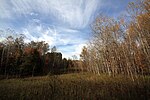Strange, Ontario
Strange is an unincorporated community west of King City in King Township, Ontario, Canada. It is directly north of Laskay to the west of Highway 400, and is a sparsely populated agricultural area. Strange was founded as Williamstown in 1841, founded by William Wells who opened a general store. He abandoned his plans to expand the community into a town in 1853 when the Toronto, Simcoe & Lake Huron railway was built through the community of Springhill (now King City) instead of Williamstown. In 1854, the community's first post office closed, but another opened on 1 March 1880 through the efforts of Frederick William Strange, for whom the post office and the community were renamed. Today, only a few residential buildings remain, and only the Presbyterian Church and two graveyards provide links to its past.
Excerpt from the Wikipedia article Strange, Ontario (License: CC BY-SA 3.0, Authors).Strange, Ontario
Weston Road, King
Geographical coordinates (GPS) Address Nearby Places Show on map
Geographical coordinates (GPS)
| Latitude | Longitude |
|---|---|
| N 43.935833333333 ° | E -79.581944444444 ° |
Address
Weston Road 13731
L7B 1M3 King
Ontario, Canada
Open on Google Maps




